Acoustic and Flow Aspects of Synthetic Jet Actuators with Chevron Orifices
Abstract
1. Introduction
2. Materials and Methods
2.1. Data Reduction
- Local centerline momentum velocity:
- Local centerline time-averaged velocity:
- Local centerline maximum velocity:where T is the operation period of the loudspeaker membrane [s], and uc is the instantaneous velocity at the orifice axis [m/s].
2.2. The Experiment Plan
- Velocity (x/d = 0, the axial distance x and diameter d are showed in Figure 1a) and impedance measurements for different frequencies. The tested frequency range was from 8 to 100 Hz, with steps of 1 Hz. The measurements were carried out at real power p = 3 W.
- The energetic efficiency measurements for different real powers at the characteristic frequency. The measurements were carried out at real power p = 0.02, 0.05, 0.1, 0.5, 1, 1.2, 5, 2.5, 3, and 3.5 W.
- The measurements of velocity in the time function at the characteristic frequency, real power p = 3 W, and x/d = 0, 3.
- The velocity measurement in the function of ratio x/d at the characteristic frequency and real power p = 3 W.
- The SPL measurement at the characteristic frequency and real power p = 5, 6, 8, 10, and 12 W.
3. Results and Discussion
3.1. A Search of Characteristic Frequency
3.2. The Efficiency Measurement
3.3. Centerline Velocity in Time Function
3.4. The Axial Distribution of Centerline SJ Velocity
3.5. Noise Level
4. Conclusions
Author Contributions
Funding
Institutional Review Board Statement
Informed Consent Statement
Data Availability Statement
Conflicts of Interest
References
- Singh, P.K.; Sahu, S.K.; Upadhyay, P.K. Experimental investigation of the thermal behavior a single-cavity and multiple-orifice synthetic jet impingement driven by electromagnetic actuator for electronics cooling. Exp. Heat Transf. 2020. [Google Scholar] [CrossRef]
- Singh, P.K.; Sahu, S.K.; Upadhyay, P.K.; Jain, A.K. Experimental investigation on thermal characteristics of hot surface by synthetic jet impingement. Appl. Therm. Eng. 2020, 165, 114596. [Google Scholar] [CrossRef]
- Smyk, E.; Gil, P.; Gałek, R.; Przeszłowski, Ł. Acoustic and Flow Aspects of Novel Synthetic Jet Actuator. Actuators 2020, 9, 100. [Google Scholar] [CrossRef]
- Salunkhe, P.; Wu, Y.; Tang, H. Aerodynamic Performance Improvement of a Wing Model Using an Array of Slotted Synthetic Jets. J. Fluids Eng. Trans. ASME 2020, 142, 1–7. [Google Scholar] [CrossRef]
- Wang, J.; Wu, J. Aerodynamic performance improvement of a pitching airfoil via a synthetic jet. Eur. J. Mech. B Fluids 2020, 83, 73–85. [Google Scholar] [CrossRef]
- Zhang, Z.; Zhang, X.; Wu, Y.; Jia, M.; Jin, D.; Sun, Z.; Li, Y. Experimental research on the shock wave control based on one power supply driven plasma synthetic jet actuator array. Acta Astronaut. 2020, 171, 359–368. [Google Scholar] [CrossRef]
- Xia, Q.; Zhong, S. Enhancement of laminar flow mixing using a pair of staggered lateral synthetic jets. Sens. Actuators A Phys. 2014, 207, 75–83. [Google Scholar] [CrossRef]
- Xia, Q.; Zhong, S. Enhancement of inline mixing with lateral synthetic jet pairs at low Reynolds numbers: The effect of fluid viscosity. Flow Meas. Instrum. 2017, 53, 308–316. [Google Scholar] [CrossRef]
- Wang, P.; Shen, C. Characteristics of mixing enhancement achieved using a pulsed plasma synthetic jet in a supersonic flow. J. Zhejiang Univ. Sci. A 2019, 20, 701–713. [Google Scholar] [CrossRef]
- Jabbal, M.; Jeyalingam, J. Towards the noise reduction of piezoelectrical-driven synthetic jet actuators. Sens. Actuators A Phys. 2017, 266, 273–284. [Google Scholar] [CrossRef]
- Mangate, L.D.; Chaudhari, M.B. Heat transfer and acoustic study of impinging synthetic jet using diamond and oval shape orifice. Int. J. Therm. Sci. 2015, 89, 100–109. [Google Scholar] [CrossRef]
- Bhapkar, U.S.; Srivastava, A.; Agrawal, A. Acoustic and heat transfer characteristics of an impinging elliptical synthetic jet generated by acoustic actuator. Int. J. Heat Mass Transf. 2014, 79, 12–23. [Google Scholar] [CrossRef]
- Bhapkar, U.S.; Srivastava, A.; Agrawal, A. Acoustic and heat transfer aspects of an inclined impinging synthetic jet. Int. J. Therm. Sci. 2013, 74, 145–155. [Google Scholar] [CrossRef]
- Arik, M. An investigation into feasibility of impingement heat transfer and acoustic abatement of meso scale synthetic jets. Appl. Therm. Eng. 2007, 27, 1483–1494. [Google Scholar] [CrossRef]
- Crispo, C.M.; Greco, C.S.; Avallone, F.; Cardone, G. On the flow organization of a chevron synthetic jet. Exp. Therm. Fluid Sci. 2017, 82, 136–146. [Google Scholar] [CrossRef]
- Crispo, C.M.; Greco, C.S.; Cardone, G. Convective heat transfer in circular and chevron impinging synthetic jets. Int. J. Heat Mass Transf. 2018, 126, 969–979. [Google Scholar] [CrossRef]
- Casalino, D.; Diozzi, F.; Sannino, R.; Paonessa, A. Aircraft noise reduction technologies: A bibliographic review. Aerosp. Sci. Technol. 2008, 12, 1–17. [Google Scholar] [CrossRef]
- Sadeghian, M.; Bandpy, M.G. Technologies for Aircraft Noise Reduction: A Review. J. Aeronaut. Aerosp. Eng. 2020, 9. [Google Scholar] [CrossRef]
- Guan, T.; Zhang, J.; Shan, Y.; Hang, J. Conjugate heat transfer on leading edge of a conical wall subjected to external cold flow and internal hot jet impingement from chevron nozzle–Part 2: Numerical analysis. Int. J. Heat Mass Transf. 2017, 106, 339–355. [Google Scholar] [CrossRef]
- Geng, L.; Hu, Z.; Lin, Y. Thrust and flow characteristic of double synthetic jet actuator underwater. Ocean Eng. 2019, 176, 84–96. [Google Scholar] [CrossRef]
- Lyu, Y.; Zhang, J.; Liu, X.; Tan, X. Experimental investigation on convective heat transfer induced by piston-driven synthetic jet with a transmission pipe. Exp. Therm. Fluid Sci. 2019, 104, 26–42. [Google Scholar] [CrossRef]
- Dancova, P.; Psota, P.; Vit, T. Measurement of a Temperature Field Generated by a Synthetic Jet Actuator using Digital Holographic Interferometry. Actuators 2019, 8, 27. [Google Scholar] [CrossRef]
- Violato, D.; Scarano, F. Three-dimensional evolution of flow structures in transitional circular and chevron jets. Phys. Fluids 2011, 23. [Google Scholar] [CrossRef]
- Crispo, C.M.; Greco, C.S.; Cardone, G. Flow field features of chevron impinging synthetic jets at short nozzle-to-plate distance. Exp. Therm. Fluid Sci. 2019, 106, 202–214. [Google Scholar] [CrossRef]
- Akbarali, I.M.; Periyasamy, S. Design and analysis of nozzle for reducing noise pollution. IOSR J. Mech. Civ. Eng. 2020, 17, 6–12. [Google Scholar] [CrossRef]
- Gil, P. Synthetic jet Reynolds number based on reaction force measurement. J. Fluids Struct. 2018, 81, 466–478. [Google Scholar] [CrossRef]
- Gil, P.; Smyk, E. Synthetic jet actuator efficiency based on the reaction force measurement. Sens. Actuators A Phys. 2019, 295, 405–413. [Google Scholar] [CrossRef]
- Smith, B.L.; Glezer, A. The formation and evolution of synthetic jets. Phys. Fluids 1998, 10, 2281–2297. [Google Scholar] [CrossRef]
- Kordík, J.; Trávníček, Z.; Timchenko, V.; Ismail, N.A.; Trávníček, Z.; Timchenko, V.; Ismail, N.A.; Atirah, N. The predominant effect of stroke length on velocity profiles at the exit of axisymmetric synthetic jet actuators. Int. J. Heat Fluid Flow 2017, 66, 197–208. [Google Scholar] [CrossRef]
- Gil, P.; Wilk, J.; Smusz, R.; Gałek, R. Centerline heat transfer coefficient distributions of synthetic jets impingement cooling. Int. J. Heat Mass Transf. 2020, 160, 120147. [Google Scholar] [CrossRef]
- Smyk, E.; Wawrzyniak, S.; Peszyński, K. Synthetic jet actuator with two opposite diaphragms. Mech. Mech. Eng. 2020, 24, 17–25. [Google Scholar] [CrossRef]
- Smyk, E.; Przeszłowski, Ł.; Strzelczyk, P.M. Impact of the confinement plate on the synthetic jet. AIP Adv. 2020, 10, 105204. [Google Scholar] [CrossRef]
- Chaudhari, M.; Verma, G.; Puranik, B.; Agrawal, A. Frequency response of a synthetic jet cavity. Exp. Therm. Fluid Sci. 2009, 33, 439–448. [Google Scholar] [CrossRef]
- Gil, P.; Strzelczyk, P. Performance and efficiency of loudspeaker driven synthetic jet actuator. Exp. Therm. Fluid Sci. 2016, 76, 163–174. [Google Scholar] [CrossRef]
- Krishnan, G.; Mohseni, K. An Experimental and Analytical Investigation of Rectangular Synthetic Jets. J. Fluids Eng. 2009, 131, 121101. [Google Scholar] [CrossRef]
- Chaudhari, M.; Puranik, B.; Agrawal, A. Multiple orifice synthetic jet for improvement in impingement heat transfer. Int. J. Heat Mass Transf. 2011, 54, 2056–2065. [Google Scholar] [CrossRef]
- Violato, D.; Ianiro, A.; Cardone, G.; Scarano, F. Three-dimensional vortex dynamics and convective heat transfer in circular and chevron impinging jets. Int. J. Heat Fluid Flow 2012, 37, 22–36. [Google Scholar] [CrossRef]
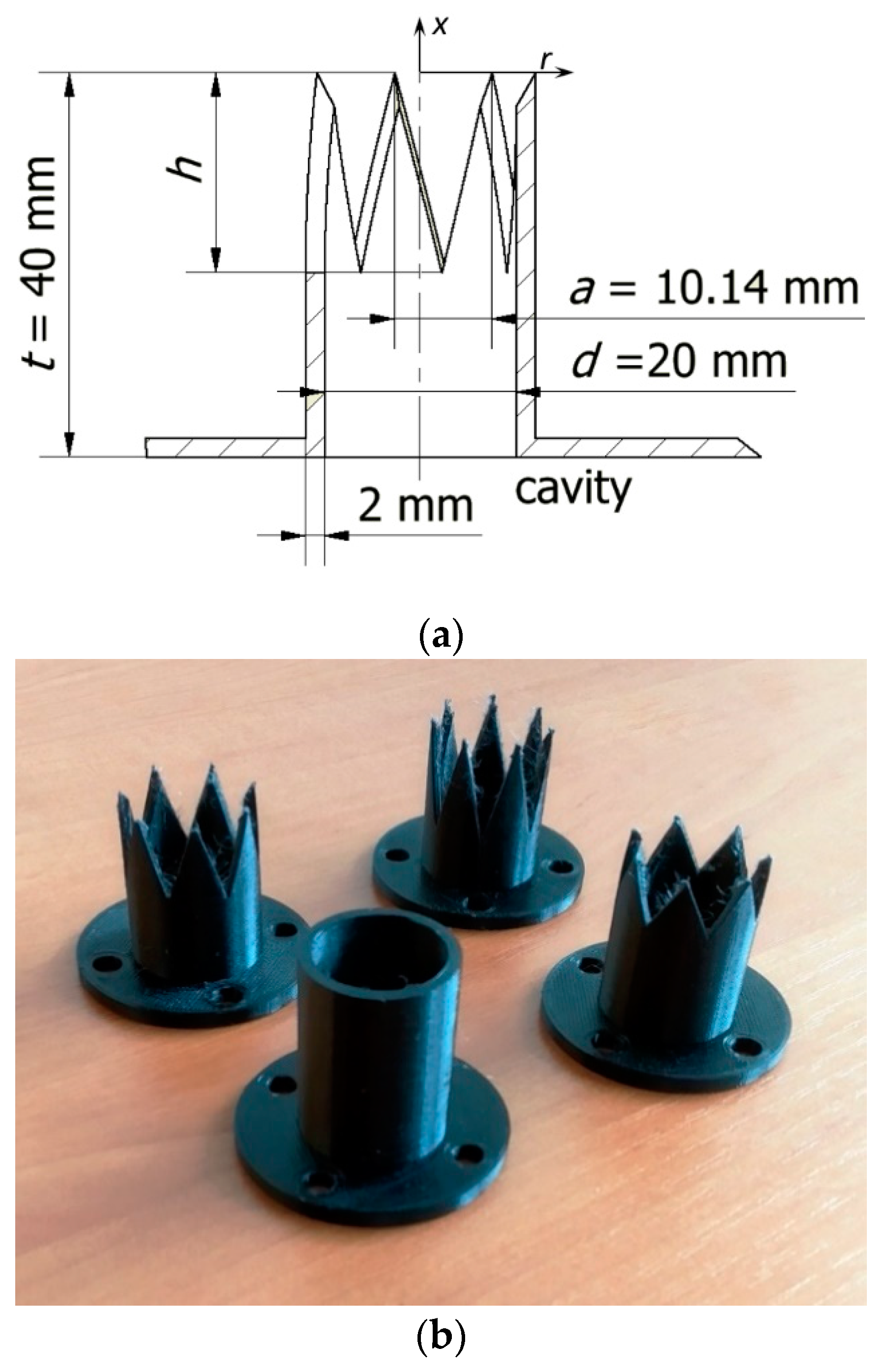


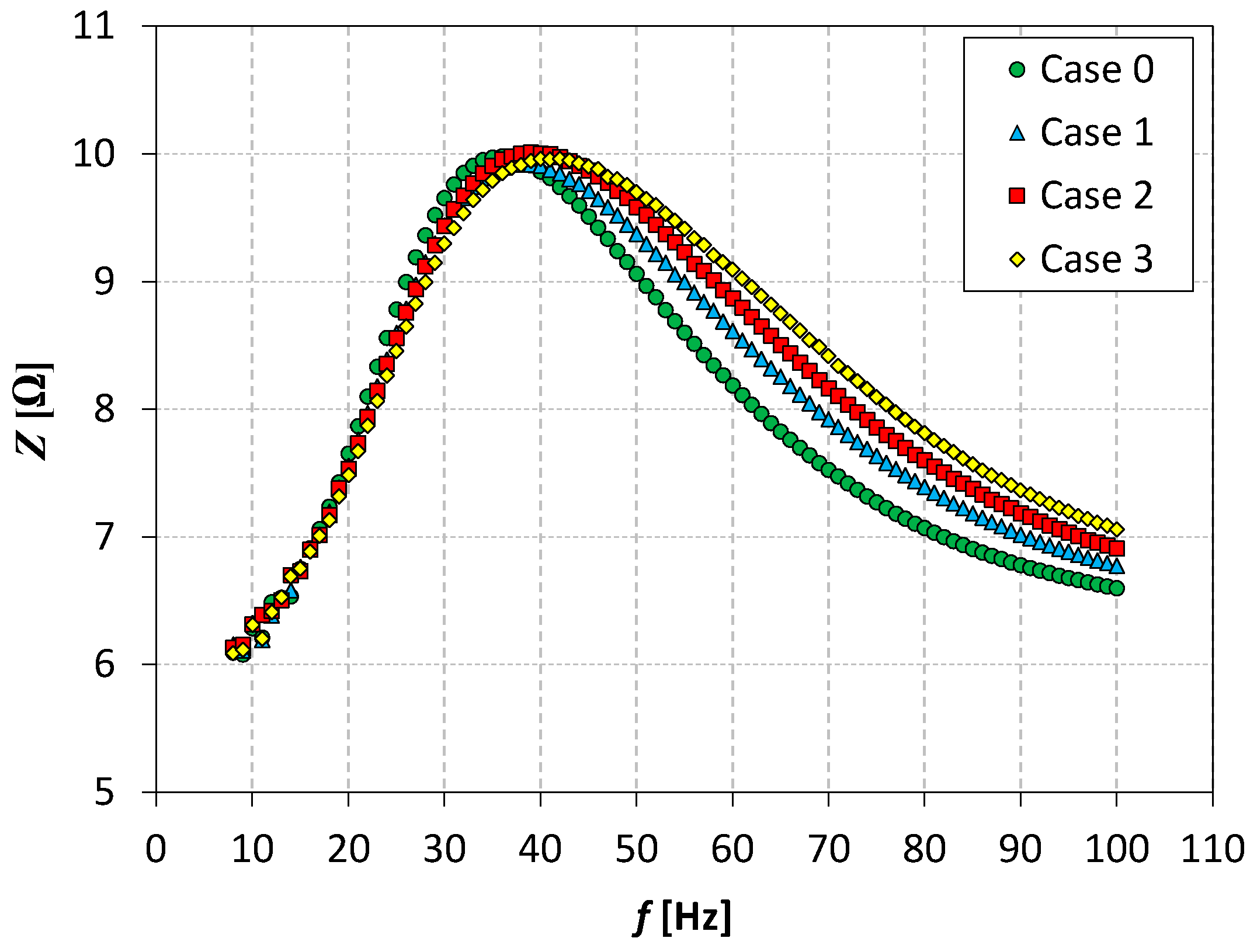
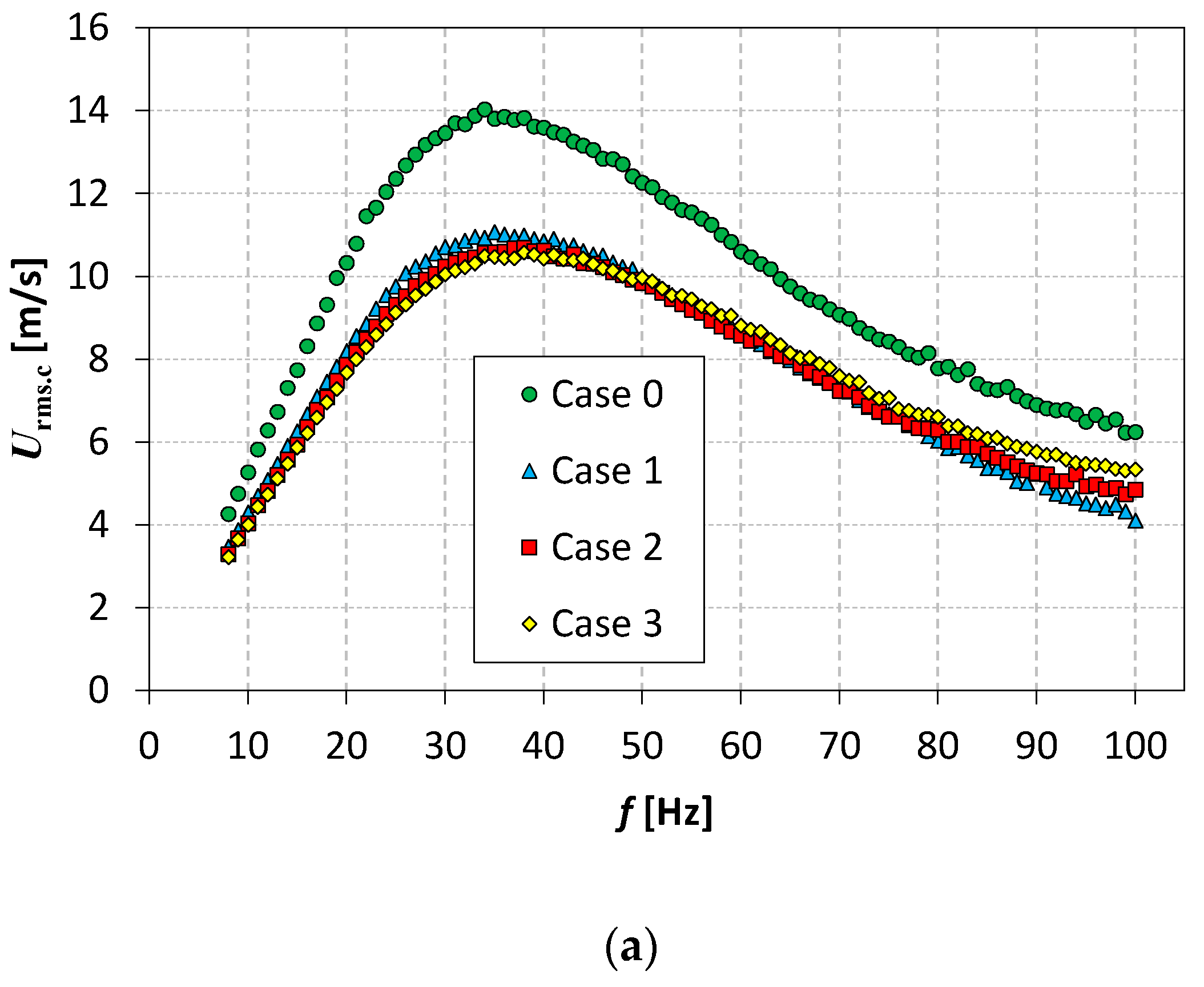
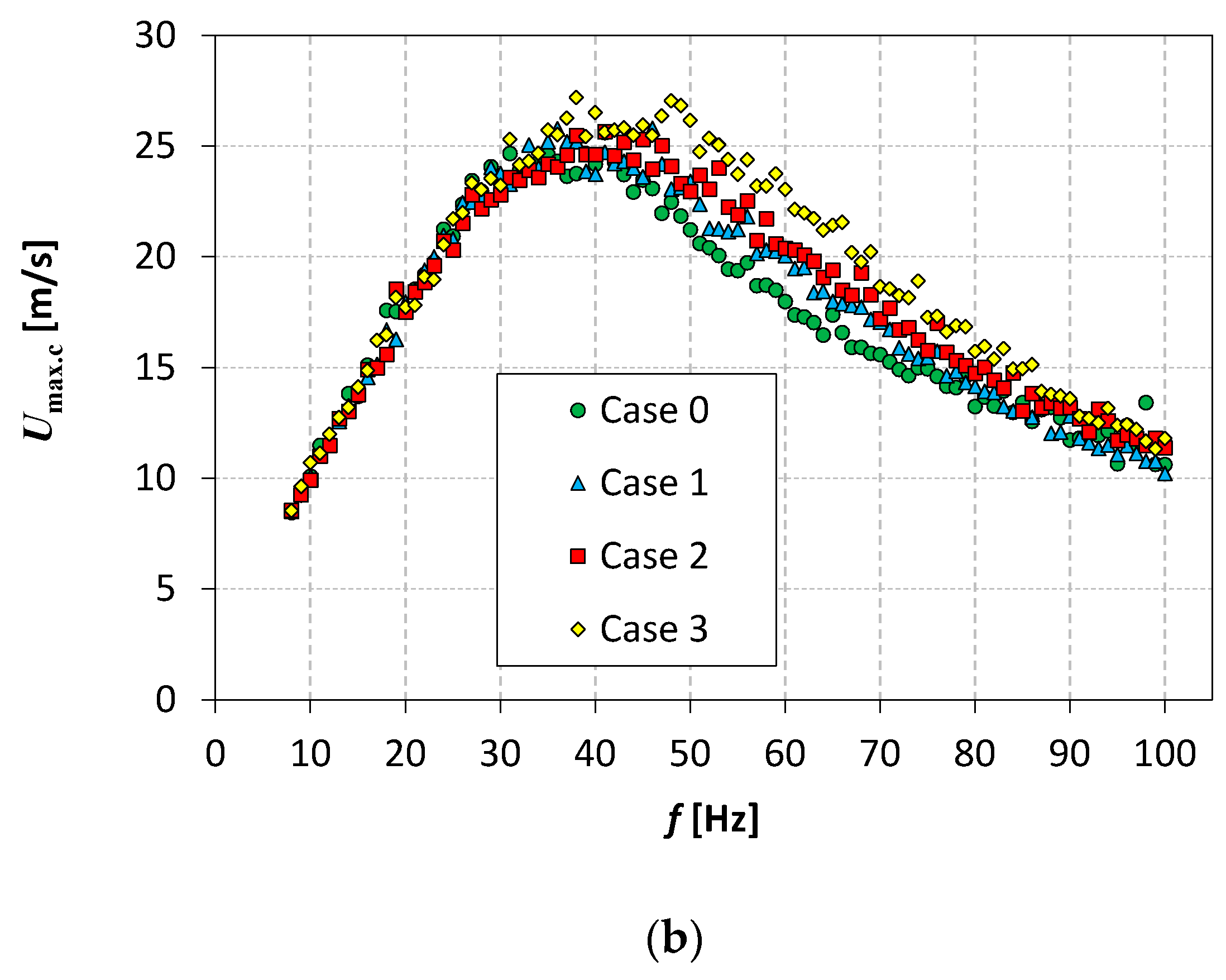
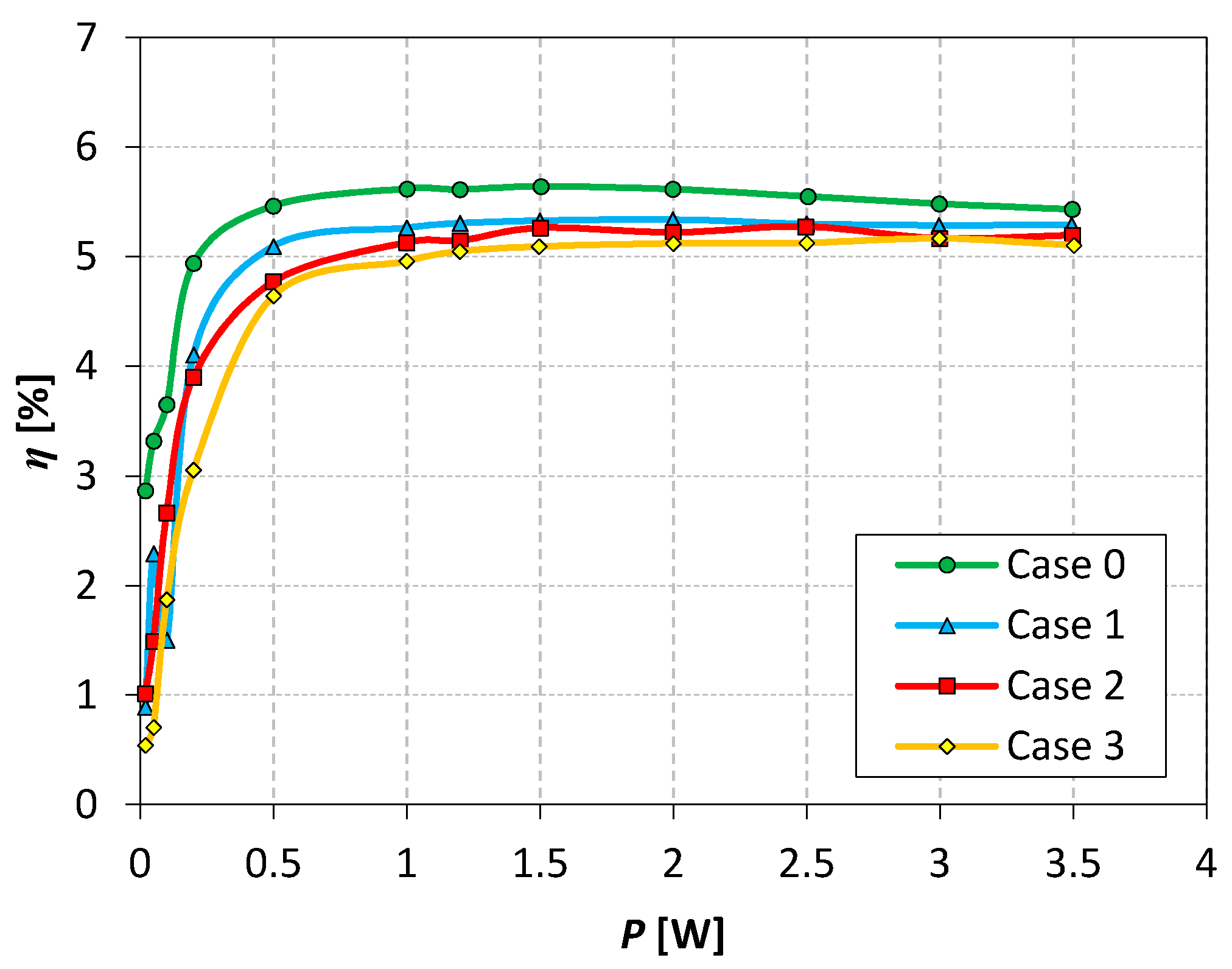
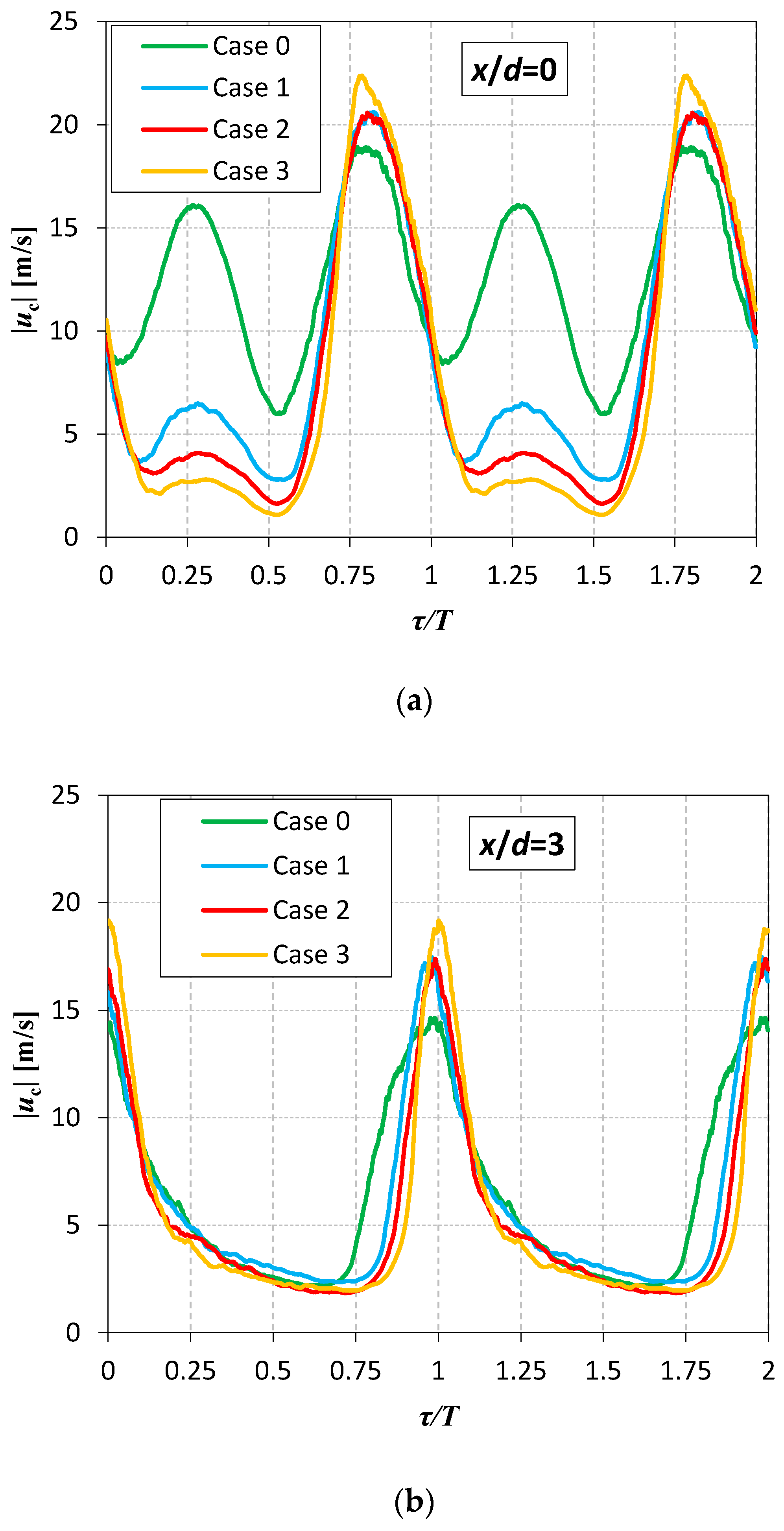
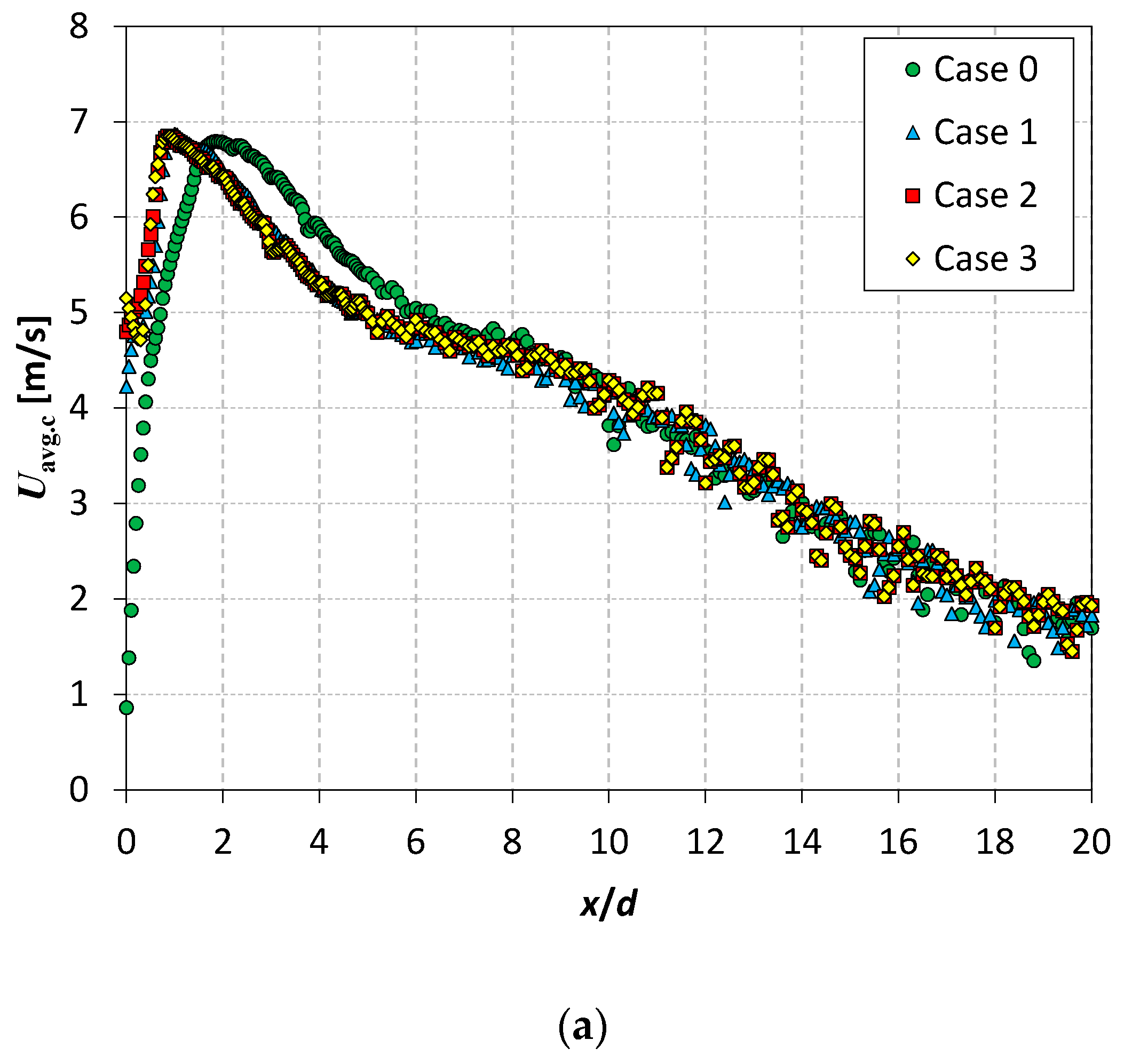

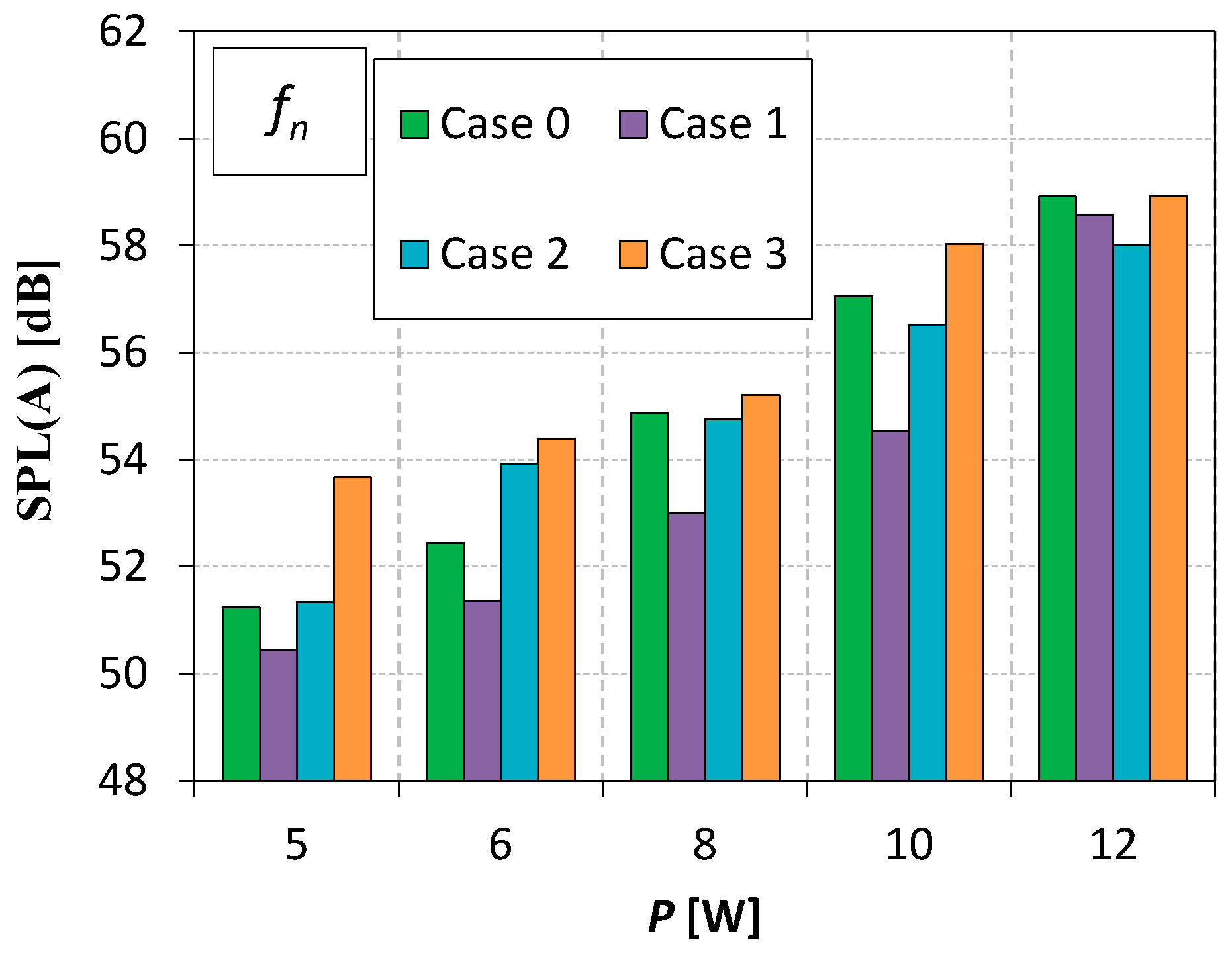
| Orifice Type | d [mm] | l [mm] | Number of Chevrons | a [mm] | h [mm] | fn [Hz] | |
|---|---|---|---|---|---|---|---|
| Case 0 | Circle | 20 | 40 | - | - | - | 36 |
| Case 1 | Chevron | 20 | 40 | 7 | 10.4 | 0.52 d (10.4) | 38 |
| Case 2 | Chevron | 20 | 40 | 7 | 10.4 | 0.76 d (15.6) | 40 |
| Case 3 | Chevron | 20 | 40 | 7 | 10.4 | 1.04 d (20.8) | 42 |
| Name | Relative Accuracy | Absolute Accuracy |
|---|---|---|
| Power, P | ±2% | |
| Force, F | ±1 mN | |
| Velocity, u (calibration accuracy) | ±2% (2.6–49 m/s) | ±0.1 m/s (<2.6 m/s) |
| Efficiency, η | ±0.2% | |
| SPL | ±1.4 dB |
Publisher’s Note: MDPI stays neutral with regard to jurisdictional claims in published maps and institutional affiliations. |
© 2021 by the authors. Licensee MDPI, Basel, Switzerland. This article is an open access article distributed under the terms and conditions of the Creative Commons Attribution (CC BY) license (http://creativecommons.org/licenses/by/4.0/).
Share and Cite
Smyk, E.; Markowicz, M. Acoustic and Flow Aspects of Synthetic Jet Actuators with Chevron Orifices. Appl. Sci. 2021, 11, 652. https://doi.org/10.3390/app11020652
Smyk E, Markowicz M. Acoustic and Flow Aspects of Synthetic Jet Actuators with Chevron Orifices. Applied Sciences. 2021; 11(2):652. https://doi.org/10.3390/app11020652
Chicago/Turabian StyleSmyk, Emil, and Marek Markowicz. 2021. "Acoustic and Flow Aspects of Synthetic Jet Actuators with Chevron Orifices" Applied Sciences 11, no. 2: 652. https://doi.org/10.3390/app11020652
APA StyleSmyk, E., & Markowicz, M. (2021). Acoustic and Flow Aspects of Synthetic Jet Actuators with Chevron Orifices. Applied Sciences, 11(2), 652. https://doi.org/10.3390/app11020652






